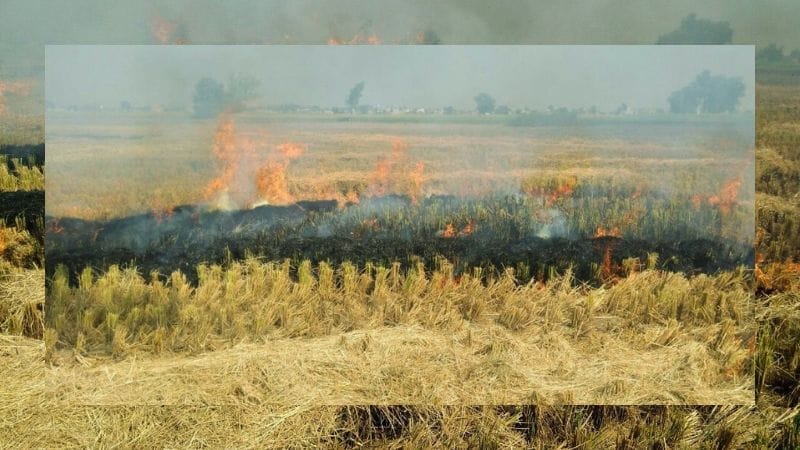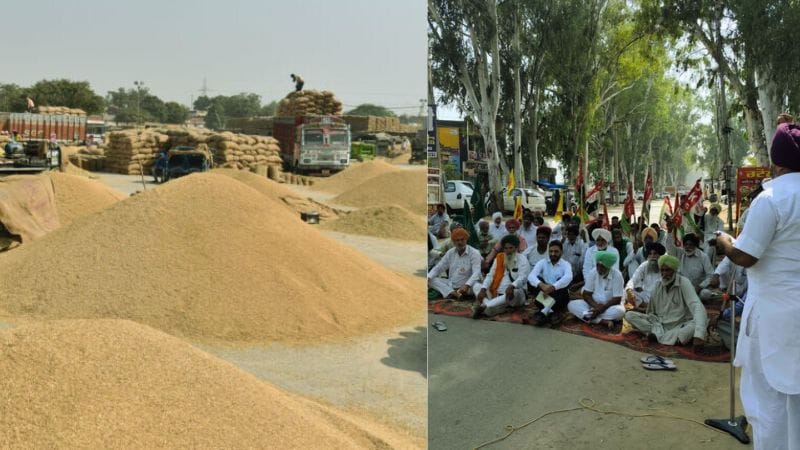Rising Air Pollution and Shifting Stubble Burning Patterns
The seasonal rise in stubble burning, a well-known contributor to air pollution in North India, has seen a major shift this year, with new trends across various states. Traditionally, stubble burning has been concentrated in Punjab and Haryana, where farmers burn crop residue post-harvest to clear fields swiftly for the next sowing season. However, recent data indicates a remarkable shift, with Madhya Pradesh surpassing Punjab in the number of stubble burning cases. As of this season, Madhya Pradesh has reported over 10,000 incidents, outpacing Punjab’s current figures and highlighting an emerging issue for policymakers focused on controlling air pollution and supporting sustainable farming practices.
Madhya Pradesh Sees a Dramatic Spike in Farm Fire Incidents
Madhya Pradesh has emerged as a new hotspot for stubble-burning. On a single day—Monday, November 5—the state recorded a staggering 506 incidents, an increase from its previous seasonal high of 296 on November 2. This one-day figure alone represents over half of the total cases logged nationwide on that day, spotlighting the increasing urgency in the region. Cumulatively, Madhya Pradesh has recorded 10,693 farm fire incidents so far this season, a count that underscores its transition from a relatively minor contributor to one of the leading states in stubble burning. This trend marks a significant environmental concern, as Madhya Pradesh’s shift to widespread crop residue burning adds to the already strained air quality in North India.
Punjab and Haryana Show Promising Declines
In contrast to Madhya Pradesh, traditional stubble burning hotspots like Punjab and Haryana have made significant strides in reducing the number of incidents. This season, Punjab, which historically has recorded the highest cases, showed an encouraging reduction, with daily incidents decreasing from 587 on November 1 to 262 by November 4. Punjab’s cumulative total stands at 4,394 incidents—a notable number but significantly lower than in previous years.
Haryana has also demonstrated an effective decline, with cases dropping from 42 on October 31 to 13 by November 4. This trend reflects the impact of policy measures, including increased enforcement of stubble burning bans and support for alternative farming methods. However, despite the positive outcomes in Punjab and Haryana, these measures have yet to be universally adopted across all states, leading to uneven results in reducing air pollution across North India.
Concerning Trends in Uttar Pradesh and Rajasthan
Besides Madhya Pradesh, Uttar Pradesh and Rajasthan are also experiencing worrisome increases in stubble burning incidents. In Uttar Pradesh, cases surged dramatically, from just 16 incidents on November 4 to 84 on November 5. Similarly, Rajasthan saw cases jump from 36 to 98 within a single day, marking the second-highest daily total this season after 100 cases were reported on October 16. The escalation in these states presents a new challenge for policymakers, as the environmental impacts of stubble burning continue to extend beyond traditional hotspots.
Why Are Farm Fires Increasing in Madhya Pradesh and Other States?
The reasons behind the uptick in stubble burning incidents in Madhya Pradesh, Uttar Pradesh, and Rajasthan are multifaceted. In regions like Punjab and Haryana, decades-long awareness campaigns, subsidized machinery for crop residue management, and stricter enforcement of stubble burning regulations have reduced the frequency of these fires. In contrast, Madhya Pradesh and other states have only recently seen a rise in agricultural intensification, resulting in more residue to manage at the end of each harvest season.
Farmers in these regions often lack access to subsidized machinery, like the Happy Seeder or the Super SMS, that can handle crop residue without resorting to burning. Additionally, the higher cost of such machinery and the lack of widespread support for sustainable farming alternatives leave many farmers with limited options. Consequently, burning remains an economically viable—albeit environmentally damaging—method for clearing fields quickly.
The Environmental Toll of Stubble Burning: Air Quality and Health Risks
Stubble burning has severe environmental and public health implications. During the harvest season, the practice contributes to nearly 45% of particulate matter in North India’s air, resulting in a sharp increase in PM2.5 and PM10 levels. These pollutants exacerbate respiratory illnesses, especially in urban areas like Delhi, which frequently records hazardous air quality levels during this time. The worsening air quality has also led to spikes in cases of asthma, bronchitis, and other respiratory ailments, affecting vulnerable groups, including children and the elderly.
With the shift in stubble burning incidents toward states like Madhya Pradesh, air quality in these regions is now seeing a substantial deterioration. As the wind patterns move pollutants across state lines, even areas previously unaffected by stubble burning-related pollution are now reporting poor air quality, underscoring the far-reaching impacts of these farm fires.
Policy Implications, The Need for a Regionally Adaptive Approach
Given the shifting trends, it is clear that policy measures need to be adapted to address both traditional hotspots and emerging ones. While Punjab and Haryana have demonstrated that effective policies, subsidies, and enforcement can yield positive results, Madhya Pradesh and other rising hotspots need similar support structures tailored to their unique needs. Experts suggest that policymakers should consider increasing subsidies for crop-residue management machinery, promoting residue-based industries, and offering incentives for adopting sustainable farming practices.
An immediate policy recommendation is to expand the availability of the Happy Seeder, Super SMS, and other tools in regions where burning has surged. Additionally, there is a need for increased training and educational programs to help farmers understand the long-term benefits of alternative residue management methods. Collaborative efforts with state governments, central policy bodies, and agricultural institutions could further bolster the efforts in states like Madhya Pradesh, Uttar Pradesh, and Rajasthan.
Future Prospects, Sustainable Farming as the Ultimate Solution
While short-term policy interventions are crucial, experts agree that transitioning to sustainable farming practices is the ultimate solution. In this context, initiatives like crop diversification—shifting away from paddy to less residue-intensive crops—can be a viable strategy for reducing stubble burning. Furthermore, encouraging crop residue recycling into biogas or biofuel can offer alternative uses for agricultural waste, thus providing farmers with an economic incentive to avoid burning.
The recent trends highlight the need for a cohesive, pan-Indian approach to tackle stubble burning. Promoting research into low-cost, environmentally friendly solutions and building resilience in the agricultural sector through government-supported programs could pave the way for long-term solutions.
An Urgent Call for Unified Action
The rise in stubble-burning incidents in states like Madhya Pradesh, Uttar Pradesh, and Rajasthan represents a new dimension in North India’s air pollution crisis. While Punjab and Haryana’s improvements show that policy interventions can be effective, the growing number of incidents in other regions signals the need for a comprehensive, regionally adaptive approach.
The current trends not only threaten air quality but also underscore a complex agricultural challenge. Policymakers, agricultural stakeholders, and local governments must act swiftly to address the shifting dynamics of stubble burning across India, advancing toward a sustainable agricultural future that benefits both the environment and the rural economy.
Stay connected with NH Punjab on social media. Follow us on Facebook, Twitter/X, and Instagram for the latest news updates, behind-the-scenes content, and more. Engage with us online and be a part of our growing community.

Punjab Farm Fires Cross 4,000 Mark in 2023, Sparking Concerns Over Rising Pollution
Punjab Farm Fires Cases Cross 4,000, Spark Environmental Concerns Punjab, India – November 3, 2023: In a concerning development, Punjab has recorded over 4,000 farm fire incidents this crop season, with the Punjab Remote Sensing Centre (PRSC) reporting a total of 4,132 cases of active fire events between September 15 and November 3. The recent …
Stay connected with NH PUNJAB, where your news journey begins.

BKU Ugrahan Ends Protest Over Paddy Procurement Delays, Shifts Focus to Assembly Bypolls
BKU Ugrahan Ends Paddy Procurement Protest, Announces New Campaign for Punjab Bypolls Sangrur, Punjab – November 3, 2023: After two weeks of protests across Punjab, the Bharatiya Kisan Union (Ugrahan) today ended its demonstrations against the delayed paddy procurement and lifting process. The agitation, which began on October 18, had seen farmers rallying across multiple …

